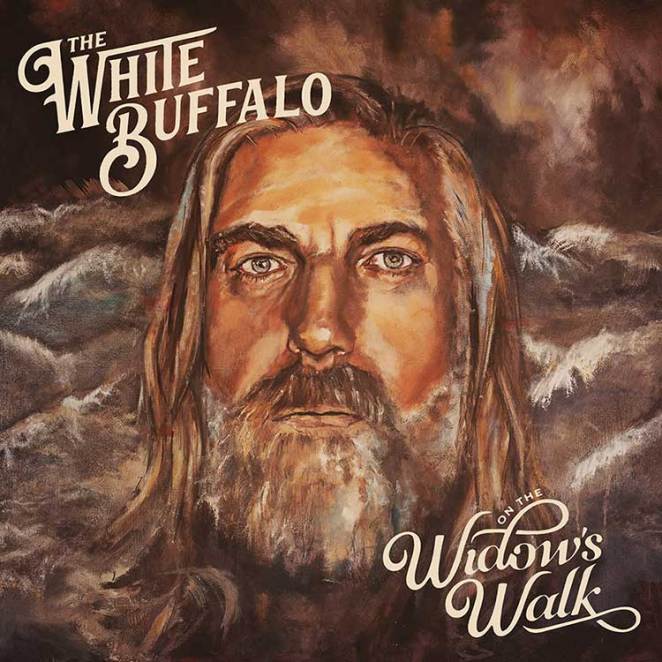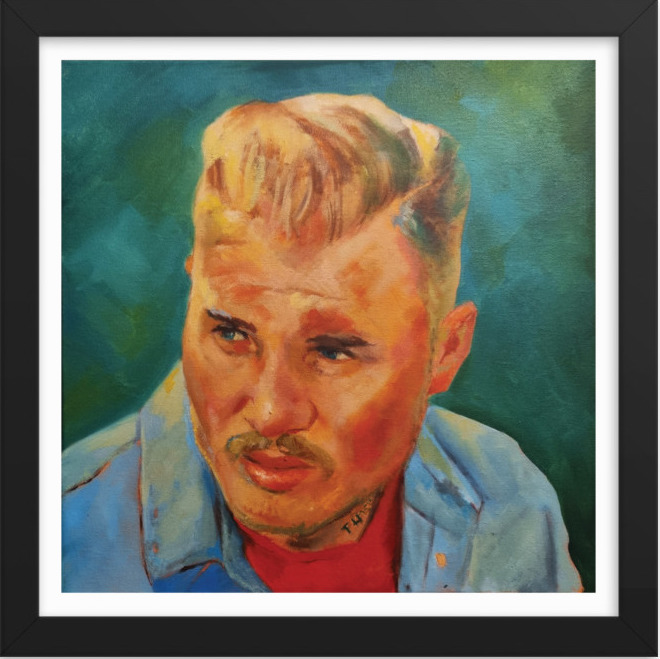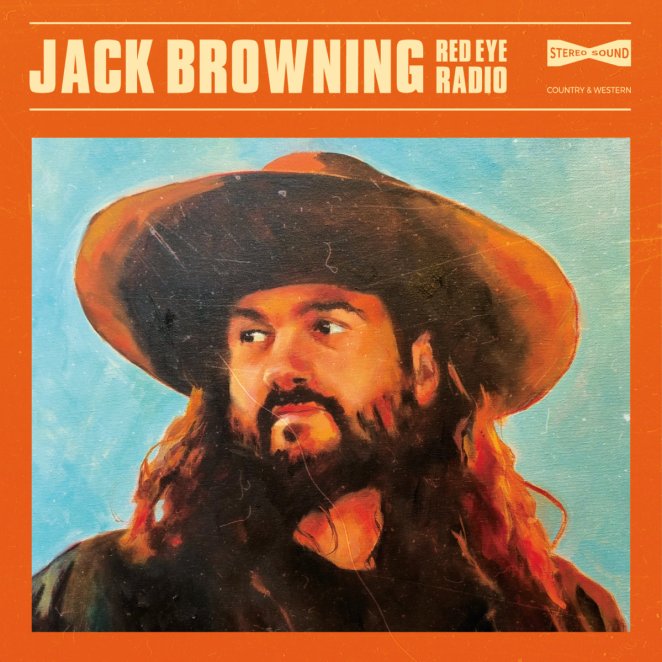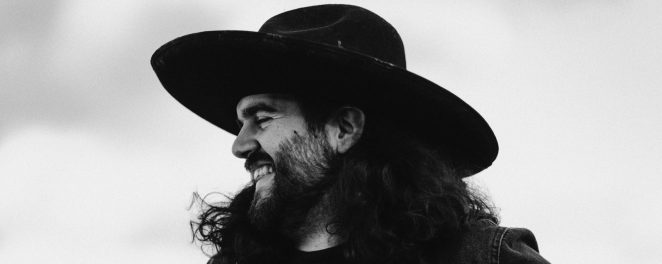After leaving college in 2016, Jack Browning moonlighted as a visual artist, while playing in a band, touring Europe with everyone from Jeff Beck to Joss Stone. When the pandemic hit, the London-based visual artist, songwriter, and musician quit his band to work in construction by day and paint by night.
Throughout the years, Browning, now 25, painted portraits of musicians as gifts for friends and family before being commissioned by The White Buffalo, Oregon singer and songwriter Jake Smith, to paint his next album cover. “I’d met him [Smith] in 2018 when he saw a portrait I painted of him and invited me to a show in London,” Browning tells American Songwriter. “Then here I was 18 months later, sworn to secrecy and on several very late-night video calls painting the cover for what became his 2020 record ‘On The Widow’s Walk.’”
That project set the trajectory of Browning’s work as an artist. “To have someone as big as Jake and his team put that confidence in me to deliver something so important to him meant a lot,” says Browning, “and that was the point where things started snowballing.”
For the next few years, Browning was still trying to find his “voice” in his artwork, pulling advice from podcasts and personally connecting with artists he admired. “That taught me the power of just communicating with people who you look up to,” said Browning. “They’re only human after all.”
After attending ateliers and workshops, by March 2023, Browning started painting again and produced a portrait of country-blues artist Charley Crockett. “I just started painting a lot of folks in this current resurgent boom of good, honest, roots music,” shares Browning.
“I always admired the portrait painting tradition of artists documenting people of their time,” adds Browning. “That usually manifested itself in powerful people, politicians, and royalty, people like that. I started to wonder how a painter from a century ago might combine their craft with documenting this whole community that’s grown around country, blues, and folk music.”
Along with works rooted in Western imagery and historical figures, Browning’s core pieces span musical icons and personalities with fine art prints of Dolly Parton, Johnny Cash, John Prine, Tom Petty, Tom Waits, Townes Van Zandt, and more contemporary artists like Zach Bryan and Nolan Taylor.
Videos by American Songwriter

“Every time I worry for some nonsensical reason that I’ll run out of subjects,” says Browning, “I discover someone else whose music I’ve come to adore, and the cycle repeats.”
After releasing his debut solo single “Gallows Pole” in 2018 and “Walkin’ Man” in 2020, Browning delivered his debut album Red Eye Radio in 2023 and has found a better balance between his two loves. Produced by Dan Lucas and mastered by Charlie Francis, Red Eye Radio is a collection of songs “waiting for the right moment to appear.”
“To see how my work has been received has been nothing short of thrilling, from the acts themselves to their family, friends, management, and other people on the scene,” says Browning. “I’m really very honored to play a small part in documenting some of these folks.”
Browning recently spoke to American Songwriter about painting some of the most iconic figures in Americana, roots, country, and rock, making music again, and how an obsession with Spaghetti-Westerns and The Highwaymen helped transport him from rural England thousands of miles away to the pictorials of Western culture.
American Songwriter: What was it about Western culture and music that has always captured you, in your art, and music?
Jack Browning: I suppose like a lot of people, it started with a mix of Spaghetti-Westerns and my Dad’s record collection. My uncle had this horrendously kitsch scale figurine of John Wayne and even aged 7 I knew that was a bit wild. That being said, I think going around and watching those movies on a weekend afternoon and then catching Clint Eastwood films with my old man must have had an impact, even if it didn’t properly surface until my 20s.
[RELATED: 4 Songs You Didn’t Know Clint Eastwood Wrote for Artists]
Then of course there was the music. The first song I ever remember being completely obsessed with, was “The Highwayman” by Willie [Nelson], Kris [Kristofferson], Johnny [Cash], and Waylon [Jennings]. I was so obsessed that the day after I heard it for the first time, I scaled my Dad’s CD tower cabinet to steal the disc again and run it through my kid’s hi-fi system in my room. The acrobatics could have gone horribly wrong in retrospect, but I think it was worth it.

As I got older, and especially when I was trying to find out why this 20-something-year-old from the UK was focussing so much on the music, art, and literature of a culture thousands of miles away. From a more intellectual perspective, during my studies, it was a process of trying to bottle the warm feeling I got in my stomach when I found a new painting that captivated me, or a piece of literature about The West as a concept. I got that feeling when I first spoke with Mark Maggiori about his early paintings, when I read Desert Solitaire, and the same again when I heard Luke Bell for the first time, for example.
I realized pretty soon it was the everyday people in that space that interested me, be they the people documenting it in art and photography, the storytellers in their songs and writings or just connecting with people who work on the ranches. The narratives were very attractive to me as a boy born in London but raised in rural England. That’s still all I’m trying to capture in my songs or my paintings if you boil it right down.
AS: Your style, its tone, are unique. When painting, what is it that you want to convey around each subject, particularly the musical artists you’ve painted?
JB: I’m glad I’ve been able to start carving out something that looks a little more like my work. I think if you break it down all I’m trying to do is document the story of the person I’m painting. A lot of people leveled my work at the start with being “fan art” or whatever, and I suppose in a sense it is. I don’t find that a misnomer. After all, anyone I paint I paint because I’m a fan of them and their work first and foremost. Pretty quickly, I realized that I wanted to do more than just a flat representation. I wanted to capture my relationship with that artist and their work, and if I know them personally, a little about what makes them who they are.
For example, Tom Waits was a revelation when I discovered Mule Variations in school and to me, the swampy vibes of that record accompanied me on many a late, long drive home from a show only to be up in a couple of hours for school again. Those feelings have remained super nostalgic, so when I painted him, I tried to capture that wit and that charm, but also keep the composition pretty dark and dramatic like the album.
A lot of my portraits, given their nature and the fact I’m still based on the wrong side of the Atlantic, are based at least on photographic reference so I want to take this opportunity to thank those folks who have allowed me to collaborate with their art to make mine.
AS: You released Red Eye Radio last year. How long did it take to piece together the album, and how far back do some songs go for you?
JB: Country and Western music has always been with me, but like everything it ebbed and flowed and would disappear for years whilst I bought my first leather jacket and played in metal bands all through school. It wasn’t really until the pandemic when I left the band and tried to figure out what I wanted to write and perform that it came back and hit me like a truck.
Red Eye Radio is my debut album, and the way I described it to folks was like a little retrospective on my first seven years of adulthood and all the change and tumult that can bring a man. I wrote the first song from what would become the record, Kerosene, back in 2020. Then for two and a half years, I was quite possibly the world’s worst songwriter because I didn’t write anything else. I convinced myself I couldn’t write a good song or that people didn’t like my voice and that stifled me.
In September 2022, I had a big shift in personal circumstances. I was working a construction job again, not doing a whole lot with my art for much the same reason as the music, and I had this moment when I realized I wasn’t sure when I’d be able to record something. With the support of my fiancee Anne and my best friend Rob, who told me years ago, before I even contemplated singing in public, that when I wanted to record something, we’d make it happen, I headed into The Joplin House here in England with the great Dan Lucas to record “a song or two.”
It became pretty clear in the three weeks leading up to the studio that all these songs were coming out and we ended up with 11 tracks which became that album. I guess the bulk of the album came together in three weeks, but a lot of the content and the things I discuss on it go way back to childhood and things were just waiting for the right moment to appear. It’s funny because we recorded it on the fly and everything around it was entirely independent and self-funded by our small motley crew.

AS: What is the significance of the title ‘Red Eye Radio’?
JB: Back when I started touring again after the pandemic, my fiancee would often travel with me and she put together this amazing playlist which included a lot of the folks I’ve come to count amongst my portrait subjects. We named that playlist Red Eye Radio, which was a nod to the long nighttime drive back from and between shows. It sounded like an old amateur CB station, like something a trucker from a Jerry Reed song might listen to, and so we named it that.
When we first started listening to the first mixes of the record, we both remarked “Hey, that song could fit straight into ‘Red Eye Radio'” and well, when it came to naming the record, it took care of itself.
AS: How would you describe yourself as a songwriter? How do songs typically come to you, or come together?
JB: For the longest time they didn’t come to me at all. Much like the painting, I’ve always been intent on remaining a keen pupil, and not believing I know best or being too proud to admit when I’m stuck or drawing a blank. I always find going back to folks I admire helps the best. When I realized I had to write at least one or two more songs to make the session worth it, I just went back to playing fun, playing with chords and words. On top of that, I used my pantheon of songwriters like a reference library: “How did John Prine approach this? What did Tom Waits do that made this song so appealing to me?”
I wrote the bones of all the songs for the record at home on the couch after a day on the job, but they came alive once we were in the studio. In hindsight, it was incredibly stupid to be so unprepared, but I really thrive on the collaboration and we’d start each day in the live room—just me, Wiza Kaluba on bass and Rick Kent on drums and we’d blast through a track, sometimes composing parts on the spot with a wry grin or a frantic nod. Dan [Lucas], my producer, would be in the live room, pulling things together.
We’d reconvene, and then once we found a live take we were drawn to, Rick might go back in and play another drum track from which we’d work backward and rebuild the song. Tons of what you hear on the record is actually those initial morning jams that we’d cut to see how songs I’d been writing alone would translate in a band setting.

When we were done, I worked virtually with several friends of mine, including Pat Lyons on steel, mandolin, banjo, baritone guitar, and a host of other things. Brant Tilds added trumpet, Brian Eade added harmonica, and Wes Brook added keys, so it was a real collaborative effort. I owe it to all of them for helping bring these ideas in my songbook to life with their skill and vision.
AS: Who are some other musical subjects you’re working on now or have yet to paint?
JB: When I started this series, it was just working from my little playlist I curate for myself on my phone. Then I jokingly told friends and people who asked that I had “The List” and now life imitates lame jokes because I do just have this comically long list pasted to the wall of my studio. Whenever I post a new painting I always ask folks who they’d like to see, and who they’re listening to, so from each finished work I get at least four or five ideas. It’s pretty dizzying if I stop and look at what’s ahead.
I’ve [painted] a portrait of my friend Willi Carlisle on the go, as well as a portrait of one of the songwriters who started this whole journey for me, Willie Watson. There’s another portrait of Riley Downing, which is nearly done. Riley and I connected after I posted the initial sketch. I want to try and honor some of the classic acts (think Tammy Wynette, Merle Haggard, Waylon Jennings). A great way to start is by collaborating with the Kentucky venue Sip & Spin where we’re putting together the largest collection of my paintings in one place to honor people who’ve had an impact on the scene there.
Moving forward, I’d love to rack up more work painting album art, especially after my fiancée and I produced my album sleeve. That and any collaborations to honor some of the musicians out there today by working with them, their teams or, if they’ve passed, honoring their memory in the best way I know how.














Images Courtesy of Jack Browning
To purchase prints by Jack Browning go HERE.
